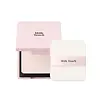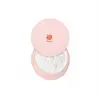What's inside
What's inside
 Key Ingredients
Key Ingredients

 Benefits
Benefits

 Concerns
Concerns

 Ingredients Side-by-side
Ingredients Side-by-side

Talc
AbrasiveSilica
AbrasiveMagnesium Stearate
Cosmetic ColorantMethyl Methacrylate Crosspolymer
Mica
Cosmetic ColorantCaprylic/Capric Triglyceride
MaskingBoron Nitride
AbsorbentTriethylhexanoin
MaskingDiisostearyl Malate
EmollientPhenyl Trimethicone
Skin ConditioningDimethicone
EmollientCaprylyl Glycol
EmollientTitanium Dioxide
Cosmetic ColorantGlyceryl Caprylate
EmollientEthylhexylglycerin
Skin ConditioningCalamine
AbsorbentIron Oxides
Triethoxycaprylylsilane
Tocopherol
AntioxidantTalc, Silica, Magnesium Stearate, Methyl Methacrylate Crosspolymer, Mica, Caprylic/Capric Triglyceride, Boron Nitride, Triethylhexanoin, Diisostearyl Malate, Phenyl Trimethicone, Dimethicone, Caprylyl Glycol, Titanium Dioxide, Glyceryl Caprylate, Ethylhexylglycerin, Calamine, Iron Oxides, Triethoxycaprylylsilane, Tocopherol
Silica
AbrasiveTalc
AbrasiveBoron Nitride
AbsorbentDimethicone
EmollientPhenoxyethanol
PreservativeSodium Dehydroacetate
PreservativePolydiethylsiloxane
EmollientSilk Powder
Skin ConditioningAlcohol
AntimicrobialParfum
MaskingCalamine
AbsorbentPrunus Persica Fruit Extract
AbrasiveButylene Glycol
HumectantArgania Spinosa Kernel Oil
EmollientZingiber Officinale Root Oil
MaskingEnantia Chlorantha Bark Extract
Skin ConditioningBeta-Sitosterol
Emulsion StabilisingSerenoa Serrulata Fruit Extract
Skin ConditioningTocopherol
AntioxidantOleanolic Acid
Skin ConditioningSilica, Talc, Boron Nitride, Dimethicone, Phenoxyethanol, Sodium Dehydroacetate, Polydiethylsiloxane, Silk Powder, Alcohol, Parfum, Calamine, Prunus Persica Fruit Extract, Butylene Glycol, Argania Spinosa Kernel Oil, Zingiber Officinale Root Oil, Enantia Chlorantha Bark Extract, Beta-Sitosterol, Serenoa Serrulata Fruit Extract, Tocopherol, Oleanolic Acid
Ingredients Explained
These ingredients are found in both products.
Ingredients higher up in an ingredient list are typically present in a larger amount.
Boron Nitride is compound consisting of boron and nitrogen. It is used to absorb oil and modify adherence/ slip in products.
This means it is often used in makeup products to help them last longer.
We don't have a description for Calamine yet.
Dimethicone is a type of synthetic silicone created from natural materials such as quartz.
What it does:
Dimethicone comes in different viscosities:
Depending on the viscosity, dimethicone has different properties.
Ingredients lists don't always show which type is used, so we recommend reaching out to the brand if you have questions about the viscosity.
This ingredient is unlikely to cause irritation because it does not get absorbed into skin. However, people with silicone allergies should be careful about using this ingredient.
Note: Dimethicone may contribute to pilling. This is because it is not oil or water soluble, so pilling may occur when layered with products. When mixed with heavy oils in a formula, the outcome is also quite greasy.
Learn more about DimethiconeSilica, also known as silicon dioxide, is a naturally occurring mineral. It is used as a fine, spherical, and porous powder in cosmetics.
Though it has exfoliant properties, the function of silica varies depending on the product.
The unique structure of silica enhances the spreadability and adds smoothness, making it a great texture enhancer.
It is also used as an active carrier, emulsifier, and mattifier due to its ability to absorb excess oil.
In some products, tiny microneedles called spicules are made from silica or hydrolyzed sponge. When you rub them in, they lightly polish away dead skin layers and enhance the penetration of active ingredients.
Learn more about SilicaTalc is a clay mineral. It helps absorb moisture and improve the texture of products. Like other types of clay, Talc can have a slight exfoliating effect on skin. Talc can be added to increase the volume of products.
Some Baby powders are made by combining talc with corn starch. The word "talc" comes from Latin and originates from Arabic. Talc is a mineral commonly found throughout the world.
If you have any concerns about using talc, we recommend checking out the FDA's official page.
Learn more about TalcTocopherol (also known as Vitamin E) is a common antioxidant used to help protect the skin from free-radicals and strengthen the skin barrier. It's also fat soluble - this means our skin is great at absorbing it.
Vitamin E also helps keep your natural skin lipids healthy. Your lipid skin barrier naturally consists of lipids, ceramides, and fatty acids. Vitamin E offers extra protection for your skin’s lipid barrier, keeping your skin healthy and nourished.
Another benefit is a bit of UV protection. Vitamin E helps reduce the damage caused by UVB rays. (It should not replace your sunscreen). Combining it with Vitamin C can decrease sunburned cells and hyperpigmentation after UV exposure.
You might have noticed Vitamin E + C often paired together. This is because it is great at stabilizing Vitamin C. Using the two together helps increase the effectiveness of both ingredients.
There are often claims that Vitamin E can reduce/prevent scarring, but these claims haven't been confirmed by scientific research.
Learn more about Tocopherol